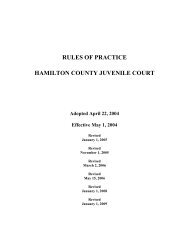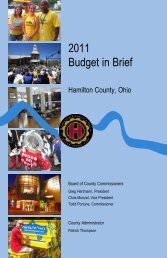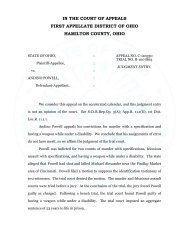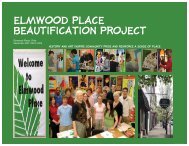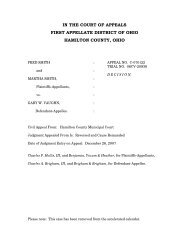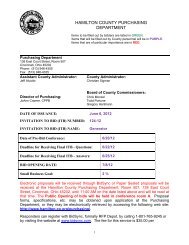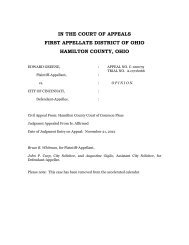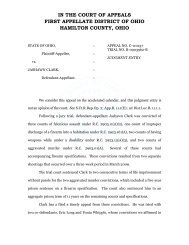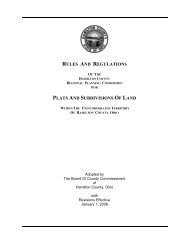Planning in The Age of Sprawl - Hamilton County, Ohio
Planning in The Age of Sprawl - Hamilton County, Ohio
Planning in The Age of Sprawl - Hamilton County, Ohio
You also want an ePaper? Increase the reach of your titles
YUMPU automatically turns print PDFs into web optimized ePapers that Google loves.
Metropolitics. “Contrary to popular belief, socioeconomic <strong>in</strong>stability does not stop neatly at<br />
central-city borders. As it crosses <strong>in</strong>to <strong>in</strong>ner suburbs, especially <strong>in</strong>to suburbs that were once<br />
blue-collar and middle-class neighborhoods, it accelerates and <strong>in</strong>tensifies. Central cities<br />
have a fiscal, governmental, and social <strong>in</strong>frastructure to slow these powerful trends. Lack<strong>in</strong>g<br />
the central city's central bus<strong>in</strong>ess district tax base, welfare <strong>in</strong>frastructure and network <strong>of</strong><br />
organized political activity, <strong>in</strong>ner suburbs <strong>of</strong>ten decl<strong>in</strong>e far more rapidly.” Older suburbs <strong>in</strong><br />
urban counties, also known as “first suburbs” and “grayfields” are mature, land-locked and<br />
built-out. <strong>The</strong>y can quickly spiral <strong>in</strong>to decl<strong>in</strong>e due to erosion <strong>of</strong> population, hous<strong>in</strong>g stock,<br />
jobs and tax base. <strong>The</strong> decl<strong>in</strong>e is <strong>of</strong>ten rooted <strong>in</strong> state policies that encourage “greenfields”<br />
development (build<strong>in</strong>g on vacant undeveloped land) and do not provide equal opportunities<br />
to established communities with “grayfield” redevelopment opportunities. Avoid<strong>in</strong>g rapid<br />
decl<strong>in</strong>e <strong>of</strong> older suburbs <strong>in</strong> urban counties requires partnerships that promote public policies<br />
for ma<strong>in</strong>ta<strong>in</strong><strong>in</strong>g the vitality <strong>of</strong> our established communities rather than creat<strong>in</strong>g disposable<br />
communities. This partnership <strong>of</strong> “first suburbs” will be a critical element <strong>in</strong> any strategy to<br />
reverse the decl<strong>in</strong>e <strong>of</strong> older communities <strong>in</strong> <strong>Hamilton</strong> <strong>County</strong>.<br />
A RANGE OF CAUSES<br />
<strong>The</strong> literature also conta<strong>in</strong>s various explanations regard<strong>in</strong>g the causes <strong>of</strong> sprawl. <strong>Sprawl</strong> is<br />
no doubt the outcome <strong>of</strong> two great American liberation movements: personal transportation<br />
and a spread <strong>of</strong> your own—largely born <strong>in</strong> the 1950’s and go<strong>in</strong>g strong today. Both are<br />
outgrowths <strong>of</strong> federal policies and the availability <strong>of</strong> money after World War II. <strong>The</strong><br />
National Defense Highway Act <strong>of</strong> 1956 created the <strong>in</strong>terstate highway system for quick<br />
<strong>in</strong>ter-city and <strong>in</strong>ter-coastal mobility and to deliberately disperse <strong>in</strong>dustry <strong>in</strong>to the<br />
countryside – theoretically mak<strong>in</strong>g it less vulnerable to nuclear attack. <strong>The</strong> Federal Hous<strong>in</strong>g<br />
Adm<strong>in</strong>istration created the other suburbanization driver – the guaranteed mortgage. This<br />
f<strong>in</strong>ancial <strong>in</strong>strument built the American suburbs with low down-payment, long term, fixed<br />
<strong>in</strong>terest mortgages, essentially riskless to banks. <strong>The</strong>se behemoth federal policies cont<strong>in</strong>ue<br />
to drive the suburban character and overpower local plann<strong>in</strong>g <strong>in</strong>itiatives that may attempt to<br />
change the conventional suburban development pattern. Accord<strong>in</strong>g to Roberta Gratz,<br />
“<strong>Sprawl</strong> cont<strong>in</strong>uation makes sense only with recognition that to tame it, stop it, unravel it,<br />
and dramatically alter a 50-year, entrenched national development pattern, an entire<br />
<strong>in</strong>terrelated network <strong>of</strong> rules must be fundamentally changed. Inertia is the enemy <strong>of</strong><br />
change”.<br />
New levels <strong>of</strong> <strong>in</strong>ertia are expected to emanate from technology. Digital electronics will<br />
cont<strong>in</strong>ually make it possible for cities to become more and more dispersed and polarized<br />
s<strong>in</strong>ce <strong>of</strong>fice work will travel rather than <strong>of</strong>fice workers. <strong>The</strong> irrelevance <strong>of</strong> geography will<br />
drive the trend toward rural and decentralized workplaces -- High Technology and Low-<br />
Income Communities: Prospects for the Positive Use <strong>of</strong> Advanced Information Technology,<br />
edited by Donald Schon.<br />
We are rem<strong>in</strong>ded <strong>of</strong> the importance <strong>of</strong> American values dur<strong>in</strong>g the past two centuries by<br />
Richard Moe <strong>in</strong> Chang<strong>in</strong>g Places: Rebuild<strong>in</strong>g Community <strong>in</strong> the <strong>Age</strong> <strong>of</strong> <strong>Sprawl</strong>. He writes<br />
that Americans desire newness and change at the expense <strong>of</strong> context and stability. “Escape<br />
and start over” is a long-held American tenet. <strong>The</strong> 21 st Century will no doubt br<strong>in</strong>g new<br />
technological forces that will cont<strong>in</strong>ue decentralization trends.<br />
HCRPC<br />
PLANNING IN THE AGE OF SPRAWL<br />
7



